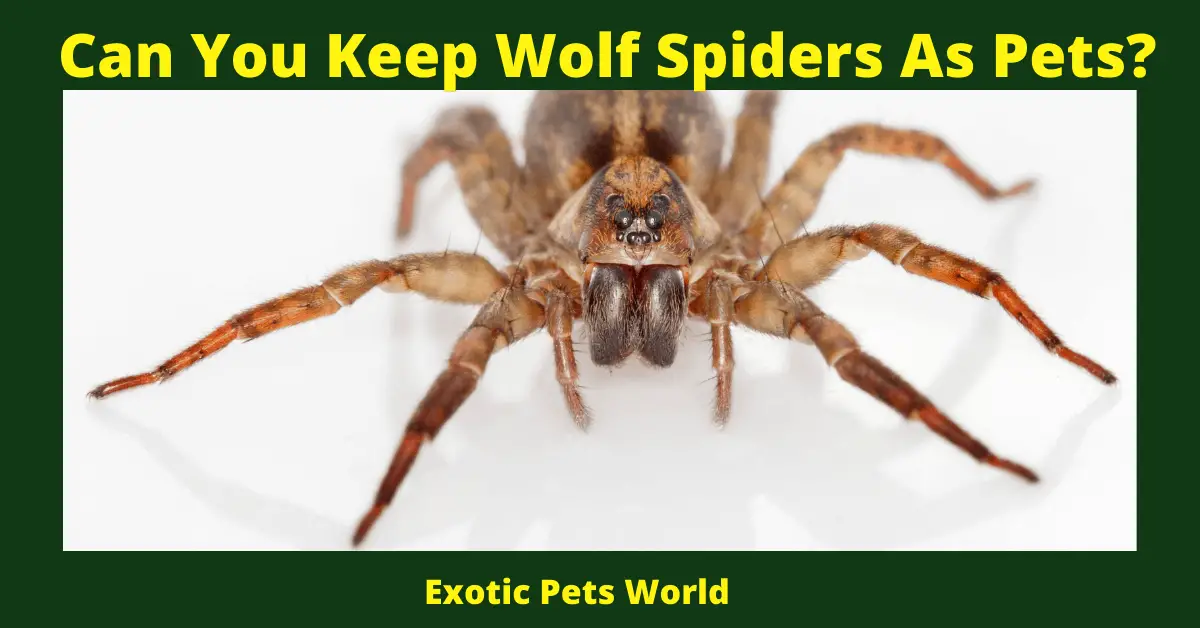Can You Keep Wolf Spiders As Pets?
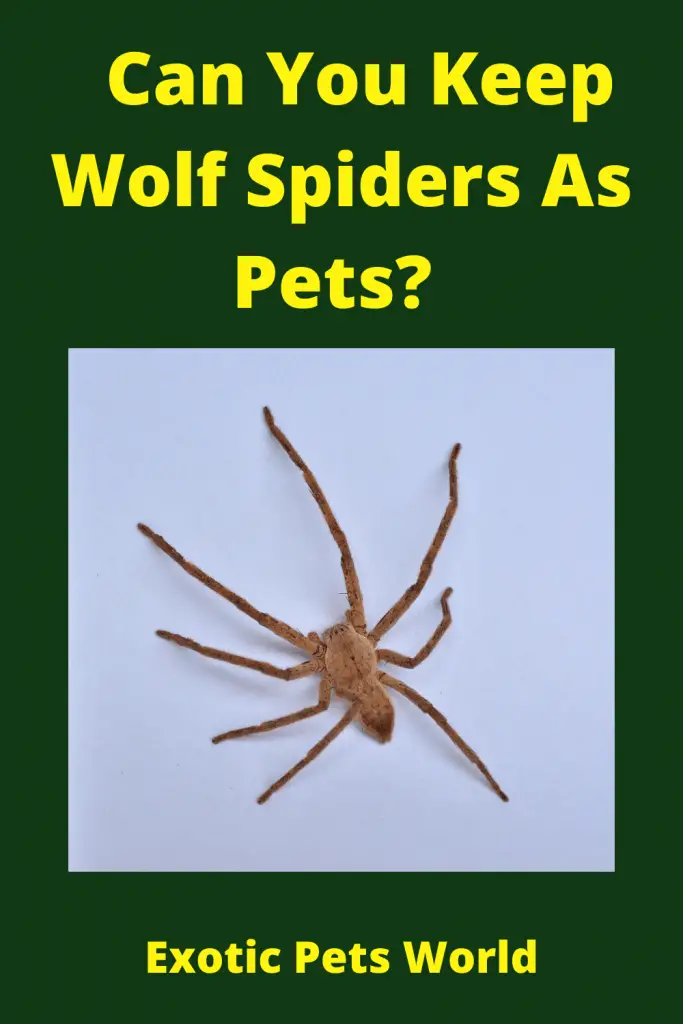
Yes, you can keep these magnificent wolves spiders as pets. If you want an undemanding, docile, and adorable pet, try keeping a wolf spider. Wolf spiders like to live in dark places.
Inverted plastic margarine tub in which holes are cut makes the best housing and shelter for them. Ensure food and water supply. Water can be delivered by soaking a small piece of sponge and keeping it free from mold.
Most people think twice about keeping a wolf spider as a pet. They find it dangerous and frightening because of the various urban legends told about it. But for those looking for an exciting but low-maintenance pet, the wolf spider is the answer. Jump to Wolf Spiders: Comprehensive Guide
In addition to low maintenance, they also cost less. Fortunately, one thing that made wolf spider the best pet is that you don’t have to spend extra money on pet supplies or pet clothes, and grooming equipment. They require a minimum amount of food, water, and the optimal environment, nothing else.
The wolf spider is one of the enormous spiders in Nebraska. They are usually present outdoors, and only accidentally find their way inside the house. Usually, they wander around homes and buildings. Many people who look at wolf spiders for the first time confuse them with tarantulas because they have a lot of hair. But they are not dangerous or poisonous as tarantulas.
Unique Eyes of Wolf Spiders
Although some wolf spiders are large, there are many smaller species also present. Regardless of their size, wolf spiders are eminent by a specific pattern of eyes. Their eyes are arranged in two rows (upper and lower). Their lower row has four little eyes. The upper row is recreated with a large pair of middle eyes facing forward and a small pair of lateral eyes located at the farther side.
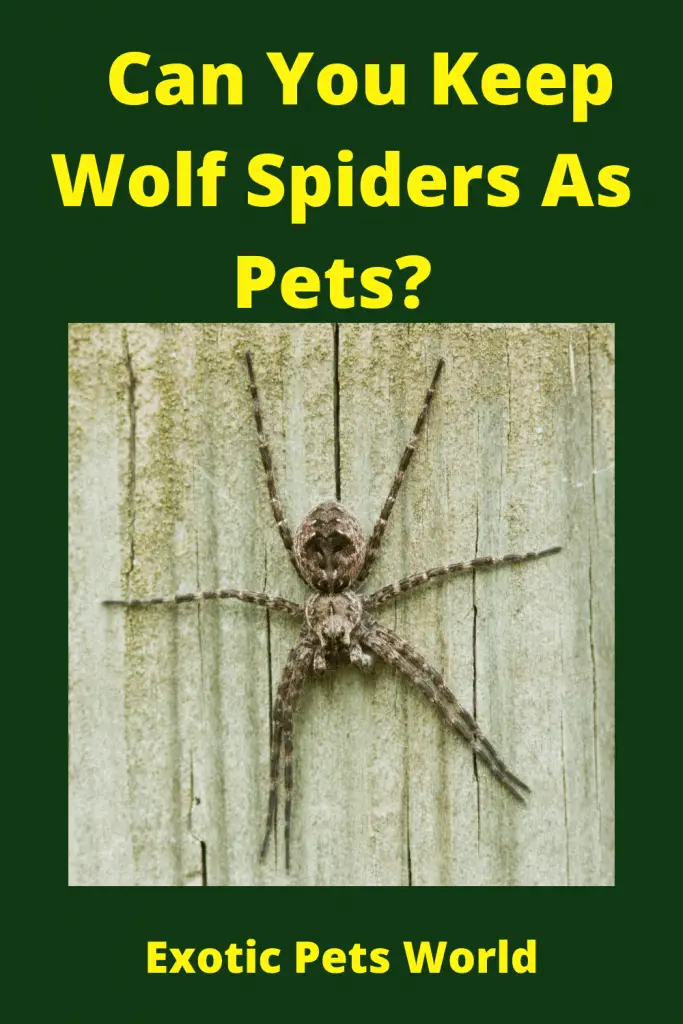
Personality of Wolf Spiders
Wolf spiders do not make nets or webs to catch their prey but are very active hunters. They usually ambush or prey freely. They have been given this name (wolf spider) because they attack their prey forcefully and pounce on their victims. Wolf spider not only use their eyesight to detect prey, but they also use their eyes to detect vibrations.
In the wild, wolf spiders are common in terrestrial habitats but are often found in high shrubs or dense grasslands where prey is highly prevalent. When they do not actively hunt or search for food, they can be found hiding under rocks or other objects. Some species even dig holes in the soil.
How Long do Wolf Spiders Live in Captivity? 4 Years
In captivity, their average life span increases due to optimal environment along with better feeding and nourishment. Some people keep them as pets, and in captivity, they can live up to four years.
Are Wolf Spiders Good for Anything?
“The wolf spider is harmless and controls the valuable pests around our homes and our backyards,” said Nancy Henkel, a Professor of Entomology at the University of Georgia. As their name suggests, wolves are predators and prey on their own. So they are suitable for cleaning the small pests around the house if they sat free and allowed to roam in the house.

Are Wolf Spiders Harmful to Pets?
Wolf Spider Venom
Spider venom can be very toxic to pets. The smaller your pet is, the more spider venom will infect them. But some spiders, like wolf spiders, are not as dangerous. They have less poison; they bite only when someone is continuously disturbing them, and when they are under tremendous stress.
Due to their hiding and ambushing nature, they less come in direct contact with your other pets.
If you have any indication that your pet may have been bitten by a spider, see a veterinarian as soon as possible.
How to Take Care of Wolf Spiders?
Caring for a wolf spider is very easy. You need a few items for enclosure and proper housing.
Items you will need are given below:
- Small terrarium or other escape-proof enclosure
- Small stones, twigs, or leaves
- Clean, pesticide-free soil
- A Hole in The Ground
- A place to find bugs
Wolves spiders do not spin nets/webs, which means they do not need a lot of space places to live. A 2.5-gallon aquarium/terrarium provides enough space for a wolf spider to make its home. As an alternative to building a web, wolf spider will make its home in a hole in the ground.
For proper housing of wolf spiders give at least one inch of clean, pesticide-free soil or more and some leaves, small rocks, or twigs. (The artificial plants and stones you find at pet supply stores will work just fine.)
Ensure your spider tank lid is ventilated, but it must be escape-proof, even if they are diurnals. Wolf spiders prefer darkness so that you won’t need any particular light. A daily fogging or misting will help keep your pet wolf spider home comfortable and humid.
Wolf Spider Diet
Now you know about wolf spider housing properly, and you want to make sure it is adequately fed. As you might expect, wolf spiders mostly eat worms, insects, or any living thing that is too small to catch and eat. They will eat small lizards, frogs and even little birds.
In the wild, wolf spiders like to be alone and do not rely on nets to catch their food. They are hunters who chase or ambush their prey. To keep the wolf spider as a pet, you need to be prepared to provide live insects at least every other day. If your wolf spider has babies, they will even need the small live prey, occasionally.
Adult Wolf Spider Diet
In the forest, the wolf spider will eat the prey that is smaller than it. As a pet, your wolf spider will consume almost every living prey in its tank or cage. However, you should limit prey size to half the size of your wolf spider.
Possible prey items you can offer to your wolf spider include:
- House flies
- Moths
- Mosquito
- Cricket
- Mealworms
- Worms
- Other Insects
You can buy live cricket directly at most pet stores or catch live prey around your home or outdoors. Give the prey alive so that the spider can prey on it and kill it. If the spider has not attacked and killed the live prey after a few minutes, remove the prey and try to feed your wolf spider again later.
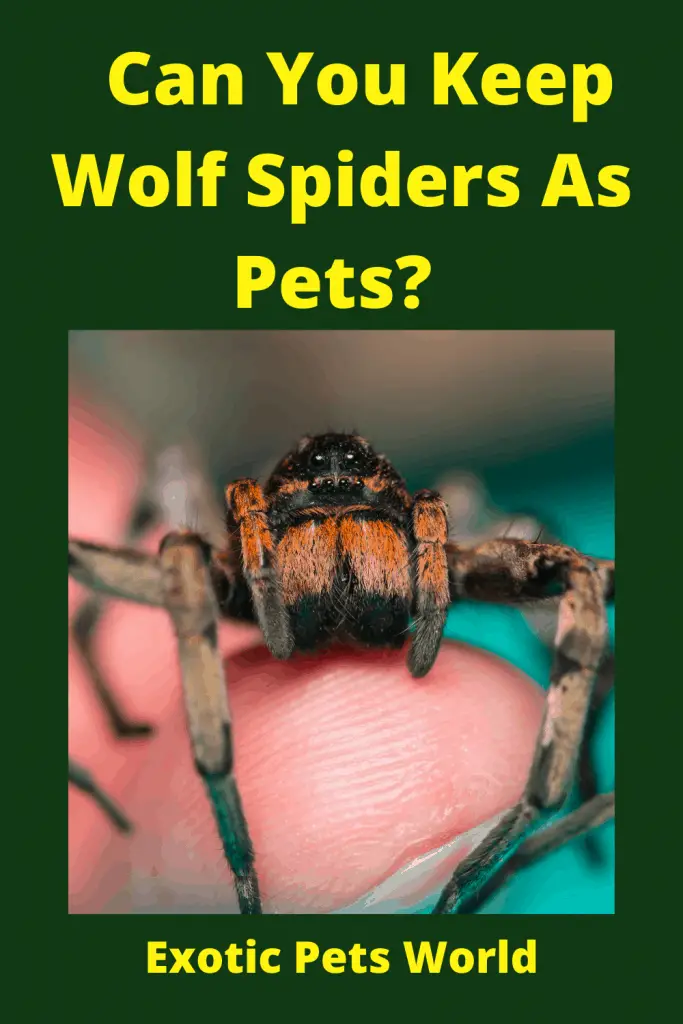
Feeding Frequency
The number of times you feed your wolf spider depends on two things:
- The size of the prey you deliver
- The size of your pet wolf spider
If you are feeding a small prey species, then feed only once a day. With large prey species for a wolf spider, one meal every two days is sufficient. Although it is good to provide feed every two days, the wolf spider can go without food for more than a week and adjust its metabolism when there is a lack of prey.
Feeding Wolf Spiderlings
If your wolf spider happens to be a pregnant female and hatches her own family of spiderlings, or baby spiders, she will feed them for the first few days of life. Unlike most spiders, the wolf spider carries its new hatchlings on its back.
During this time, babies usually live off the remnants of the egg bags that hold them. When the nurturing period is over, the mother wolf spider will go away, and then the pet owner’s responsibility to provide food to baby spiders.
Separate baby spiders from each other at this time, so they don’t start eating on their siblings, then feed them small prey, like fruit flies, until they mature. They do not require to eat as many as adult spiders do.
Generally, baby spiders can be fed once every five days.
Prefer to select something about half the size of your wolf spider. You can catch flies, worms, locusts or any other small thing which fit in wolf spider mouth and you captured that from your backyard. Make sure your spider’s food doesn’t harm it.
For example, never give any insect or fly with a stinger, such as a bee, or a venomous animal, like a centipede to your wolf spider. Do not leave the prey in your spider’s cage for more than a few minutes, to avoid the possibility of injuring your pet by prey.
Why Do Wolf Spiders Chase You?
Wolf spiders may chase you because they have fast reflexes and excellent eyesight. So due to this, they may track you if they see any harm. They even sometimes jump at you.
But, since their prey is mostly small insects,
They do not contain toxins considered dangerous to humans. So do not worry if a wolf spider chases you. They are curious and want to cuddle with you
Habitat / Cage for Wolf Spiders or Enclosure Design
Enclosure design should allow for both a naturalistic setting for the inhabitant and easily visible display for the people. Likewise, if the animals are in an unnatural and incompatible environment, their health and behaviour are likely to suffer. To reconcile these issues and any others that arise; a little time, effort and thought will go a long way creating a functional and aesthetic wolf spider habitat.
Housing Area of Wolf Spiders
Temporary and off housing for adult and juvenile spiders is relatively cheap and straightforward; it’s a pet pack! Just as simple though are any plastic or glass containers; provided it’s sealable with air holes (these can be added with a hot soldering iron) it will suit the purpose.
Pet packs are available in a range of sizes and colors tailored to the keepers’ preference. Provided the spider has enough room to roam and hunt when required, size and color are not particularly relevant.
Substrate and furnishings are simple and easy to create. If you wish for a more natural environment: have a large pet pack with the landscaped substrate (soil, sand, mulch or a mixture), furniture in the form of bark/leaves for cover, a burrow and a small Petri dish etc. as a water supply (infrequent misting will do nicely also).
Misting is particularly important in off-exhibit housing to keep humidity levels up. One technique to maintain humidity levels is to place a bin liner over the container before clipping down the lid. Setting a limited number of holes in the liner will reduce the amount of moisture that will escape.
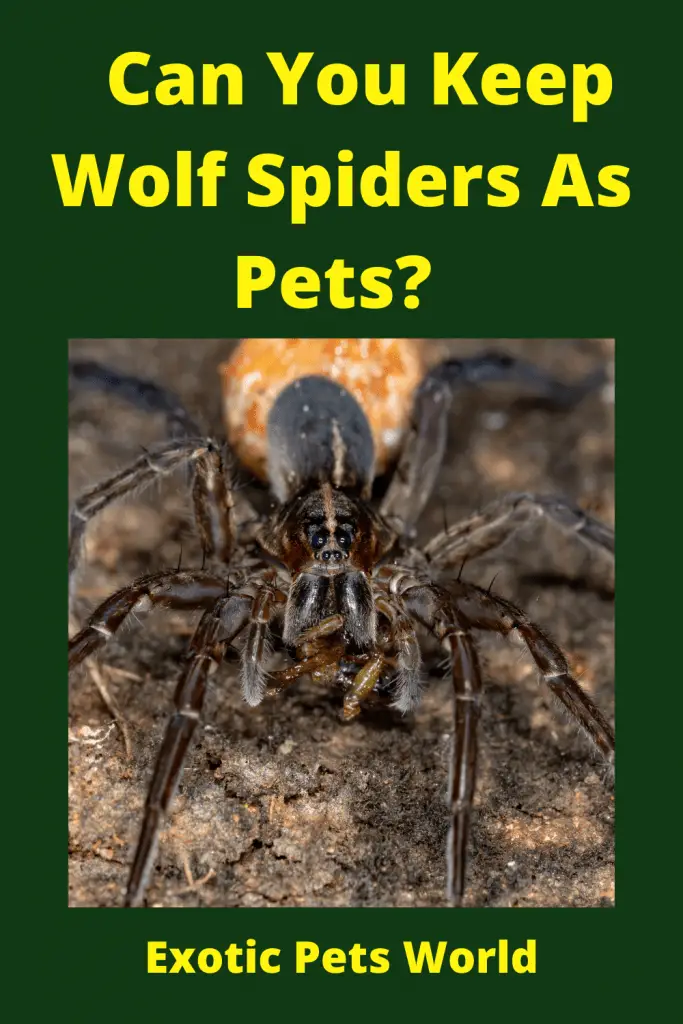
Housing for Spiderlings:
The only modification that needs to be made to a pet pack with young is the ceiling’s sealing; this can be done by merely placing an appropriate length of paper towel on the lid or between the lid and container. If you wish for a more secure, reusable and long term solution, a mesh layer can be attached permanently to the lid’s underside with sealant.
Once juveniles begin to disperse from their mother’s abdomen, they can be individually housed in smaller pet packs or similar sealable containers with appropriate sized ventilation holes and substrate.
Spatial Requirements
Wolf spiders are naturally a solitary, roaming species and should be kept as thus in captivity. More room than less and no accompanying species in their enclosure can eat or fight with is ideal. Though if two siblings have been raised together, or the desired mating pair, are housed in the one enclosure with a constant food supply coupled with familiarity towards one another should avoid any complications.
Any more than two adult spiders housed together could present a problem. It should be noted that care should be taken even when boarding an adult pair. They should be together only for a period long enough to enable copulation
Position of Enclosures
Enclosures should be kept indoors, so it is not placed in direct sunlight; the position is not an issue. This animal is nocturnal and found in several locations and conditions; provided it can construct a burrow or access some form of shelter (bark, logs, piece of cardboard) during daylight hours it will do fine.
Weather (and other) Protection
Again as spider enclosures are mostly kept indoors, this will not be a deciding factor in the design. Though should you decide to keep them outdoors well-draining soil and adequate shelters (that will not become waterlogged) are musts.
Substrate
Again, find whatever is closest to their natural environments is best; a soil/sand mix works nicely for presentation and drainage. The sand component decreases the amount of shrinkage you encounter over time from water absorption and evaporation
Common Health Problems Wolf Spiders
Very few health problems are known to spiders. Diseases and viruses do not affect them, and deformity rates are not applicable as any that do occur result in death. The issues more commonly encountered health problems involve Mite and Worm species
Mites and worms:
Laelaptid mites (genus Ljunghia Oudemans) are one mite that affects multiple spider species including Wolf Spiders. Mites are easily spotted with the naked eye. An infestation is visually observed usually.
Mites Treatment:
Treatment is simple enough; mites can be washed off using water or 70% ethanol/water blend. Great care should be taken when using ethanol around your spider as incorrect measurements and application will result in death.
A veterinarian or experienced invertebrate keeper should only do this procedure. If bathing your wolf spider is not the desired method of mite removal, biological processes can be introduced.
The Hypoaspis species of mite can be submitted to the enclosure to clear infestations as this species of mite eats other mites and fungus gnats. Prevention is common sense; good hygiene and regular substrate change, ideally before an infestation occurs, or when mites are first spotted.
Keeping your wolf spider outside is ill-advised and will lead to problems such as dehydration and desiccation, overexposure to light and inclement weather.
Warning NOTES: If you intend to keep this animal outdoors, be sure that no aerosol pesticides are being used in your area as this will be a significant hazard to your wolf spider.
Wolf Spider Exhibit:
The theme, furniture and style of the Exhibit are limited only by your imagination. The best practice is to work out your target demographic adults may spend a little longer hunting for an animal in an exhibit than children.
Are you going for a natural setting or a themed exhibit, followed by your particular species and natural habitat? A more extended exhibit is more desirable. This allows the animal to roam. It would naturally enable the public to view the spider without wandering too far or deeply into the Exhibit itself and becoming lost to the viewing eye. For species such as L. godeffroyi who like to burrow, a pre-made burrow placed at the front of the Exhibit against the glass allows the spider to be easily located even when it’s underground and hiding.
An LED red light can also be placed down the burrow to illuminate the spider without disturbing it. This method allows you to successfully view your animal in either a natural day or reverse cycle lit room, such as a nocturnal house. Substrates should be natural soil and sand blends (thoroughly cleaned and free of chemicals), as found in the bush, this allows the animal to dig should it wish to.
To avoid escapes and undesired burrows occurring in your Exhibit, a solid inner mould and pre-made hole are perfect with a thin layer (2-3cm) of the substrate over the top, if the animal burrows down they will hit the solid layer and be guided to the area in which you would prefer it to burrow (keepers can easily cover over this).
To make it all visually flow, the mold can either be made with non-toxic paint in the mix before drying (this is ideal as any scratches or chips, later on, don’t show) or painted the appropriate color when dried.
Once the Exhibit is made, furnishing is simple; dried leaves and plant matter, a few bark pieces, branches, a small buried bowl of water (with cotton wool, etc., to prevent drowning) and an optional plant two if desired. Modifications can be made along the way according to your tastes or the animal’s requirements whilst on Exhibit
Warning NOTES: Ensure that you thoroughly clean the entire Exhibit and furniture, thus removing any substances or chemicals used during construction. The last thing you want to have occurred is to produce a beautiful exhibit only to have your specimen die from residual poisoning. Another thing to be cautious of is over misting the Exhibit.
Despite living in a variety of habitats, too much moisture or humidity is not suitable for them. If a water source is present, only infrequent misting is required.
Cage cards and record sheets on exhibit doors eliminate any doubt or confusion in husbandry matters when more than one keeper is servicing the animal. It may seem to be a waste of time for an invertebrate, but when used properly, I find it to be indispensable.
Do Wolf Spiders Jump at You?
While hunting, the wolf spider often bounces on its prey. The distance of wolf spider jumping depends upon its size and breed. Fortunately, they are not satisfied with humans.
Although wolf spiders are fascinating creatures, it is not suitable for these predatory spiders to roam around your house.
Here are Some More Interesting Facts You Can Know and Enjoy.
- The wolf spiders are likely to set up a burrow in the yard that feels like nature. If you keep trimming your lawn, along with leaves raking and plucking weeds, then you will have fewer wolf spiders in your backyard.
- Wolf spiders are drawn to moist areas. If you have a leaking spot, a gutter system, or rainwater catching, you will attract these spiders inwards. Less population of spiders near your outer walls means less chance of an unwanted attack/invasion.
- The wolf spider often exploits holes made by other insects. You must regularly inspect your exterior walls and foundation and seal any entry points you find.
Final Thoughts:
Wolf spiders are very docile and unique species of spiders of multiple sizes. They are best to keep as pets because they are non-venomous/poisonous. They often live in the dark and do not make any nests. They are the best for those pet parents who require low maintenance pets.
